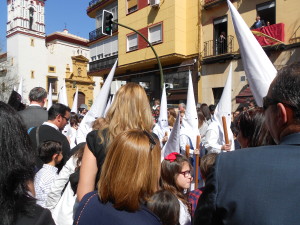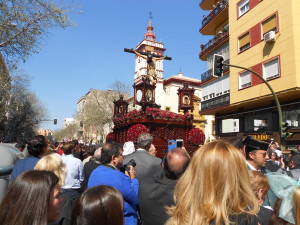31 March 2016
No Rain On The Parade
Easter celebrations in Seville
by J.R.Thomas
 “The past is a foreign country, they do things differently there” famously wrote L P Hartley in The Go-Between. We may have come to think that in modern times and after two thirds of a century of European Union that the past has faded away and that foreign countries are not nearly so foreign as they used to be. But scratch lightly the heat and dust of southern Spain and things are very different still. Not just the weather – though this Easter the one thing that both Andalusians at home and Brits at home would have been able to agree on, was that it was cold. Readers in the UK will not need reminding of that – rain and wind and grey skies proving merely an introduction to Storm Katie. Those, though, that inspected the Spanish weather forecasts and saw Andalusia as (correctly) forecast as 24/25C all Easter would probably not have shared the local view that it was cold. It was certainly simple to distinguish Brits from locals this Easter – the Brits were wearing shorts and T shirts and looking hot; the locals were wearing pullovers, hats, and scarves and looking chilly.
“The past is a foreign country, they do things differently there” famously wrote L P Hartley in The Go-Between. We may have come to think that in modern times and after two thirds of a century of European Union that the past has faded away and that foreign countries are not nearly so foreign as they used to be. But scratch lightly the heat and dust of southern Spain and things are very different still. Not just the weather – though this Easter the one thing that both Andalusians at home and Brits at home would have been able to agree on, was that it was cold. Readers in the UK will not need reminding of that – rain and wind and grey skies proving merely an introduction to Storm Katie. Those, though, that inspected the Spanish weather forecasts and saw Andalusia as (correctly) forecast as 24/25C all Easter would probably not have shared the local view that it was cold. It was certainly simple to distinguish Brits from locals this Easter – the Brits were wearing shorts and T shirts and looking hot; the locals were wearing pullovers, hats, and scarves and looking chilly.
But the differences go much deeper than this. Last week was Holy Week in Andalusia. It was of course the same in Britain, as torrents of chocolate eggs, stuffed bunnies and cheery cardboard chickens attested. But in Spain Easter is celebrated rather differently to this. For a week there are church services of utmost solemnity, underscored by celebratory processions through the streets of any reasonably sized village or town. The grandest of these are in Seville, where the processions go on almost continuously for Easter Week, with huge images carried through the streets accompanied by thousands of supporters and bands playing suitably solemn music.
The origins of the parades are obscure, but it is known that Seville has been holding these celebrations since the 16th century, when she was the richest city of the newly united Spain, and its commercial capital. The processions were symbols of the glory of Christ and the humility of the people, fuelled by the great wealth pouring in from the New World. The Spanish Catholic Church was rich and devout, showing its power and glory in magnificent new churches, palaces, and monasteries. The cathedral at Seville, built around and over the mosque previously on the site, emphasizes the power and superiority of Catholicism and contains the remains of he who was the enabler of all this wealth – Christopher Columbus. The cathedral is the core of all the processions, but they begin from their nine mother churches in the inner suburbs of Seville. Each church has a brotherhood who organise and then participate in the holy progresses; these are on a scale which is almost impossible to imagine in post Christian secular Britain today. The total active and parading membership of the brotherhoods is estimated at around fifty thousand people (women may participate now, though the brotherhoods are still predominantly men).
 What is most startling, if not downright alarming, to the unprepared visitor are the traditional costumes. The first impression is that one has inadvertently strayed into an international conference of the Klu Klux Klan, white conical hats, long robes, concealed faces. However they are leavened by each church brotherhood having distinguishing details – one wears black robes, another blue aprons over their white gowns, another gold trim. But all have faces covered in anonymity; these brothers are sinners paying humble penance by their role in the parades. But even so, the wagging coned hats towering above the crowds in the narrow streets city still causes a shock even after several days of watching processions.
What is most startling, if not downright alarming, to the unprepared visitor are the traditional costumes. The first impression is that one has inadvertently strayed into an international conference of the Klu Klux Klan, white conical hats, long robes, concealed faces. However they are leavened by each church brotherhood having distinguishing details – one wears black robes, another blue aprons over their white gowns, another gold trim. But all have faces covered in anonymity; these brothers are sinners paying humble penance by their role in the parades. But even so, the wagging coned hats towering above the crowds in the narrow streets city still causes a shock even after several days of watching processions.
In Seville there are 58 processions, each with a band, often two, predominantly brass, which generally follow the “pasos”, the towering religious statues, which are the highpoint. The first one represents the particular church, then, often an hour or more later, so long and slow are the processions, at its very end, a huge and sombre Holy Virgin, each church possessing its own. These are generally of great antiquity, some baroque, the more recent roccoco, mounted on enormous elaborately decorated platforms, with vast candelabras and carvings of gold and silver, the whole edifice surmounted by a wobbling canopy. They are of course very heavy but modernisation in the form of the wheel has yet to make any impact on their process through the streets . They are carried, literally on the shoulders of men, the “costaleros”, in groups of about twenty five, for whom this is a great honour. (It also is a continuing source of business to local osteopaths and spinal surgeons.)
Your correspondent was introduced to one costalero, appropriately named Jesus, who was carrying for the first time. He said that at first he was only conscious of the weight on his shoulders and the slow shuffle, but then came revelation, of faith, of veneration for what he was doing and the symbolism embodied in the burden he bore.
Because the platforms are so heavy they can generally only be carried a few hundred metres at a time and must then be rested. A characteristic sound of the processions is the double and treble rap of the chamberlain’s staff on the platform as he signals to “pick-up” and “set down” and “be ready”. Closest to the platforms walk a group of men, mostly but not all young, dressed in shirts and casual trousers, with rolled up mats round their shoulders – they do not, as the touristic observer might think, represent the Apostles or Disciples, but are the next set of costaleros, ready to slip swiftly under the platform when the previous set have done their duty.
There are processions afternoon, evening and night, and all night, throughout Holy Week, causing massive traffic congestion – indeed at times even pedestrians cannot move along the routes of the processions because of the sheer press of the crowds. Each brotherhood sets out from its church, with great applause from the crowds as the Virgin finally emerges from the church to follow its traditional route, although they must all pass the so-called “official section”, which starts in Calle Campana Street and passes right through the Cathedral. Once each procession leaves the Cathedral, it returns to its mother church via a different route.
 To the visiting Brit the emotion generated by these extraordinary displays of devotion is initially almost disturbing, then intriguing, and finally profoundly humbling. The enormous numbers in the crowds (most of whom appear local rather than tourists), the silence as the Virgin finally approaches, applause, and then the reaching forward of many in the crowd to touch or kiss the platform suggests continuing deep devotion. This in a country which has seen its share of anti-clericalism and priestly scandal. Even more moving are the occasions when, as the platform is rested, a female voice from a balcony will sing an unaccompanied solo, a “saeta”, a flamenco song honouring the statues. To many, these are the devotional and emotional heart of the whole process, the core of the processions. The crowd will frequently be moved to tears and then sustained clapping of these tributes.
To the visiting Brit the emotion generated by these extraordinary displays of devotion is initially almost disturbing, then intriguing, and finally profoundly humbling. The enormous numbers in the crowds (most of whom appear local rather than tourists), the silence as the Virgin finally approaches, applause, and then the reaching forward of many in the crowd to touch or kiss the platform suggests continuing deep devotion. This in a country which has seen its share of anti-clericalism and priestly scandal. Even more moving are the occasions when, as the platform is rested, a female voice from a balcony will sing an unaccompanied solo, a “saeta”, a flamenco song honouring the statues. To many, these are the devotional and emotional heart of the whole process, the core of the processions. The crowd will frequently be moved to tears and then sustained clapping of these tributes.
In a time when the Church of England, for all its attempts to be relevant and welcoming and moving with the times, its abandonment of old fashioned language and liturgy, is losing worshippers at ever faster rates, the British traveller to foreign lands perplexes over faiths that retain their strength, grow stronger even, by not changing to the times, by not adapting to a modern digital materialistic world. Most of us are simple people; when it comes to our spiritual lives what suits us best perchance are simple messages demonstrated with emotional fervour; symbols of meaning rather than academic disputations on the possible interpretations of something that might have happened. Or maybe it is just that faith under a hot foreign sun roots, like olive trees, more easily.
Please click here if you would like a weekly email on publication of the Shaw Sheet

